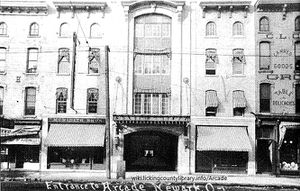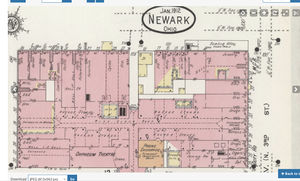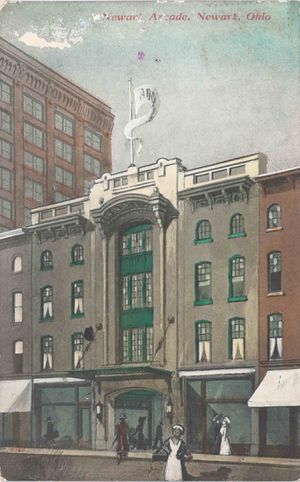Arcade
Development and Construction
Opening
After opening on June 7, 1909, a balcony above the Fourth Street entrance sat an orchestra to play for shoppers three times a week and would be used for dances held in the lobby.
Some of the noteworthy stores in the arcade at its inception included the Morse Optical Company in 1911 with Dr. Rankin at 19 Arcade, A.L Norton bookstore, Stewart Brothers and Alward furniture, J.M. Browne grocery store, Busy Bee Confections, W. A. Erman and Son drug store, Arcade Post Card store, Applegate Brothers Bicycle and Sundries, the Marietta Paint and Color Co., John Meridith Clothiers, and the Singer Sewing Machine Company - so popular they moved to a larger space in 1935 to 11 Arcade Annex. In its early years, the Arcade was known for more than its businesses. It was noted for its striking architecture and climate-controlled shopping. It had a beautiful fountain in the center walkway in front of Steward Alward Furniture Company (later removed due to the cavorting of many children and dogs playing in the water and making the walkway slippery). [8] The Arcade led to changes in the nearby Union Block space; J.M. Browne’s Grocery moved to occupy the alley fronting on the Arcade and Church Street. Browne's old room on west half was subdivided for America Talking Machine while Dana-Cates-Simpson Company, a new wholesale cigar company, received the other half of the space.[9]
Later Additions
A lit marquise was hung over the entrance, with “Arcade" was spelled out in art deco style letters on the entry way floor, which can still be seen today. Many community members remembered the elaborate plaster work throughout the arcade passageway with geometric terra cotta tropes along with terrazzo marble floors with entablature frieze columns. [10] The numerous glass pane store fronts and glass paneled roof was an architectural marvel at the time and the 3-story façade was built of quality brick by contractor P.S. Phillips. [11]A theater was built opening as “Orpheum Playhouse Theater”, featuring Vaudeville shows and in 1934 changed names to the Arcade Theater. The Arcade was rumored to have a speakeasy on the second floor and poker parties in the basement according to H.S. "Bill" DeVine, a long-time Advocate employee. [12]
According to J. King, the owner of the beauty and barber shop at 24 South Fourth Street, visitors to the Arcade would have poker parties in the basement. They could enter by Fourth Street outside entrance behind the then barber shop, with a bell system to alert gamblers in the basement if anyone wandering around outside. [13]
The fountain and theater are no longer present, but the Arcade still houses local businesses in downtown Newark.
J.S. & S.F.
Return to Historic Sites and Buildings
References
- ↑ “Newark Arcade Formally Opened,” The Newark Weekly Advocate, June 10, 1909.
- ↑ Aumann, T., “Awaiting the next chapter: The Newark Downtown Center hopes to revive interested in The Arcade,” Newark Advocate, November 24, 2008.
- ↑ “Newark Arcade was shoppers’ hot spot,” This Week in Licking County, (Newark, OH), March 20, 2005
- ↑ Newark Advocate, Oct. 25, 1907
- ↑ “Razing Landmark is Nearing Completion," Newark Advocate, Jul. 1, 1908
- ↑ "Kahn System will be used on Arcade," Newark Daily Advocate, Sep. 28, 1908, 7
- ↑ Newark Daily Advocate, Sep. 4, 1908
- ↑ Huston, A., "Arcade: Monument to Progress," The Advocate, Nov. 25, 1984, 6A
- ↑ "Changes Made in Arcade and Union Block," Newark Daily Advocate, Mar. 21, 1910
- ↑ Newark Advocate, May 2, 1979
- ↑ Newark Advocate, Dec. 14, 1911, 6
- ↑ Huston, A., "Arcade: Monument to Progress," The Advocate, Nov. 25, 1984, 6A
- ↑ Huston, A., "Arcade: Monument to Progress," The Advocate, Nov. 25, 1984, 6A


